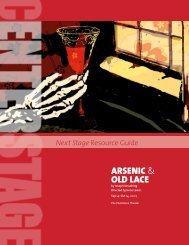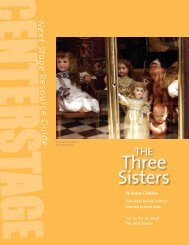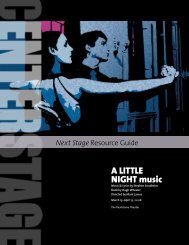The Matchmaker - Center Stage
The Matchmaker - Center Stage
The Matchmaker - Center Stage
You also want an ePaper? Increase the reach of your titles
YUMPU automatically turns print PDFs into web optimized ePapers that Google loves.
Glossary<br />
continued<br />
you pay those girls of yours too much.<br />
you pay them as much as men<br />
According to the Aldrich Report, skilled laborers in 1880<br />
were paid an average of $1.32 for a day’s work, and about 13<br />
cents an hour. Most women were paid 40-60% of their male<br />
equivalents’ wages, while children’s payscales were in the<br />
30–40% range. Less fortunate female laborers from the period<br />
worked up to 12 or 15 hours a day, with short breaks of about<br />
twenty minutes for meals.<br />
your niece is of age<br />
Though books of the period suggest 14 and 16 as proper ages<br />
to begin courtship and suggest a limit of 30, the average age<br />
of a woman who married for the first time in the 1890s was<br />
22, as opposed to 27 in the 1790s. Working-class men and<br />
women were a notable exception, often working for a number<br />
of years before marrying and not establishing their own<br />
households until their early thirties. <strong>The</strong> transition from youth<br />
to adolescence in female during the Victorian era was marked<br />
by a stark shift in clothing, especially in the coiffure and the<br />
corset. At the onset of puberty, girls were expected to pin up<br />
their hair in the “womanly” fashion (previously it had been<br />
worn down) and exchange children’s underwear for the more<br />
confining whaleboned or steel-springed variety.<br />
Next <strong>Stage</strong>: <strong>The</strong> <strong>Matchmaker</strong> | 1









